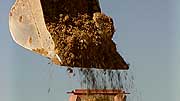Crushed Sandstone
The largest horticultural activity that has ever occurred in Australia’s history is taking place at Homebush Bay in Sydney. The development of the Olympic Park and Millennium Parklands areas has been an enormous undertaking, requiring millions of tonnes of topsoil. Usually topsoil is recovered from a site and reused, with bought topsoil making up any shortfall. However commercial soil is often excavated from areas such as river banks, and this practice is environmentally unsustainable. This type of soil also varies in quality – being very fine grained it is prone to compaction, and it can contain weed seeds.
DIY Soil
After reusing the topsoil on the Olympic site, the extra soil needed was made from waste materials. Most of the sandstone dug out for the Eastern Distributor and the new airport railway tunnel was sent to Olympic Park. 5,500 truckloads of waste sandstone was crushed to the various particle sizes required. The final texture is that of a loamy sand. Soil scientist Simon Leake believes this is the topsoil of the future. It has many qualities including:
excellent drainage
resistance to compaction
no weed seeds
it is similar to natural loamy sand
waste materials are utilised in its manufacture
Millennium Markers
Hills made up entirely of waste material have been constructed at Olympic Park. The Millennium Markers, as they are called, were built to recycle waste material, act as landmarks to help people get their bearings, and also to make the landscape more interesting by adding drama and relief. The first step was to encapsulate waste from the site in impervious clay. Gypsum and fertiliser were added, followed by a layer of the crushed sandstone. Finally a layer of coarse compost was raked over the top, and the mounds were planted with wallaby grass. There are five rings in the Olympic symbol, and five Millennium Markers have been created. Although the man-made mountains are only a few months old, the native grasses that have been planted have established well and are thriving.
Burke’s Backyard grevillea garden
The concept of growing native plants in sandstone rubble without any soil is not new to Burke’s Backyard. About eighteen months ago Don created a native garden in the Sydney region using crushed sandstone rubble in raised mounds 1.5-2m (5-6′) high. Truckloads of rubble from the bottom of a sandstone quarry were brought in to construct the garden. No soil was used, just crushed sandstone with compost and mulch over the top. We have been following the progress of this garden over the last eighteen months, and the results have been spectacular. All the plants have grown at such an incredible rate that you’d think the garden was at least ten years old.
Further information
If you are thinking about creating a native garden, consider using sandstone rubble. Hawkesbury Sandstone is the best material to use. We recommend crushed sandstone that has a maximum diameter of 10mm, as this can be easily shovelled by hand. This material is usually sold for road base or to use under cement. It is available direct from the quarry for around $12/tonne (e.g. for a trailer load) or around $15/tonne delivered (costs vary with distance from quarry). Look up ‘Quarries’ in your local Yellow Pages or call Nolan Quarrying and Mining Co Pty Ltd, Kemps Creek, (02) 9826 1339.



